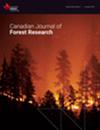驼鹿对森林采伐和经营的响应:文献综述
IF 1.5
3区 农林科学
Q2 FORESTRY
引用次数: 0
摘要
驼鹿是北方森林的象征。在许多司法管辖区,驼鹿的管理侧重于规范收获,而不太重视了解驼鹿与栖息地的关系。在回顾文献的基础上,总结了森林采伐和管理对驼鹿生态的影响。40多年的科学研究记录了森林采伐和相关活动(如造林和道路建设)的积极和消极影响。驼鹿需要空间上相邻的年轻植物群落斑块作为饲料,需要较老的森林作为热和安全覆盖。广泛和快速的森林采伐可能导致幼林的盛行,而驼鹿种群的适应性相应降低。气候变暖可能会加剧与森林覆盖大面积消失有关的负面影响。资源道路可以创造边缘栖息地,可以作为饲料,但这些特征会增加狩猎和与车辆的碰撞,并促进捕食者的移动。收获后的造林,包括除草剂的使用,可能会造成林分条件,提供很少或低质量的饲料。驼鹿的生态和社会效益取决于森林管理,即提供新旧森林的混合,采用保留足够覆盖物和饲料植物的造林,并最大限度地减少道路的发展。本文章由计算机程序翻译,如有差异,请以英文原文为准。
Response of Moose to Forest Harvest and Management: A Literature Review
Moose are an iconic symbol of northern forests. In many jurisdictions, the management of moose has focused on regulating harvest with less emphasis on understanding moose-habitat relationships. We reviewed the literature and summarised the effects of forest harvest and management on the ecology of moose. Greater than 40 years of scientific studies document both positive and negative effects of forest harvest and associated activities such as silviculture and road building. Moose require spatially adjacent patches of younger plant communities for forage and older forests for thermal and security cover. Extensive and rapid forest harvest can result in the prevalence of young forest with a corresponding reduction in the fitness of moose populations. A warming climate likely will exacerbate the negative effects associated with the broad-scale removal of forest cover. Resource roads can create edge habitat that may serve as forage, but those features result in increased hunting and collisions with vehicles and facilitate the movement of predators. Post-harvest silviculture, including the application of herbicides, can create stand conditions that provide very little or low-quality forage. The ecological and societal benefits of moose are dependent on forest management that provides a mix of old and young forest, employs silviculture that retains adequate cover and forage plants, and minimises the development of roads.
求助全文
通过发布文献求助,成功后即可免费获取论文全文。
去求助
来源期刊
CiteScore
4.20
自引率
9.10%
发文量
109
审稿时长
3 months
期刊介绍:
Published since 1971, the Canadian Journal of Forest Research is a monthly journal that features articles, reviews, notes and concept papers on a broad spectrum of forest sciences, including biometrics, conservation, disturbances, ecology, economics, entomology, genetics, hydrology, management, nutrient cycling, pathology, physiology, remote sensing, silviculture, social sciences, soils, stand dynamics, and wood science, all in relation to the understanding or management of ecosystem services. It also publishes special issues dedicated to a topic of current interest.

 求助内容:
求助内容: 应助结果提醒方式:
应助结果提醒方式:


